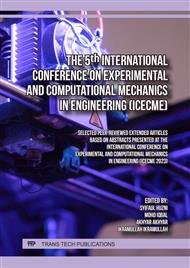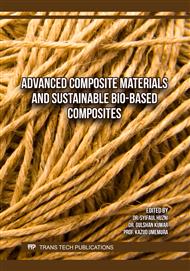[1]
Clyne, T. W., & Hull, D. (2019). An introduction to composite materials. Cambridge university press.
Google Scholar
[2]
Pakravan, H. R., & Ozbakkaloglu, T. (2019). Synthetic fibers for cementitious composites: A critical and in-depth review of recent advances. Construction and Building Materials, 207, 491-518.
DOI: 10.1016/j.conbuildmat.2019.02.078
Google Scholar
[3]
Iqbal, M., Bahri, S., & Akram, A. (2019, May). Effect of cutting parameter on tool wear of HSS tool in drilling of Kevlar composite panel. In IOP Conference Series: Materials Science and Engineering (Vol. 523, No. 1, p.012078). IOP Publishing.
DOI: 10.1088/1757-899x/523/1/012078
Google Scholar
[4]
Iqbal, M., Firmansyah, F., Tadjuddin, M., & Abhang, L. B. (2020, August). The investigation of hole delamination in drilling Kevlar composite panel using HSS drill tool. In Defect and Diffusion Forum (Vol. 402, pp.108-114). Trans Tech Publications Ltd.
DOI: 10.4028/www.scientific.net/ddf.402.108
Google Scholar
[5]
Mahir, F. I., Keya, K. N., Sarker, B., Nahiun, K. M., & Khan, R. A. (2019). A brief review on natural fiber used as a replacement of synthetic fiber in polymer composites. Materials Engineering Research, 1(2), 86-97.
Google Scholar
[6]
Rogovina, S. Z., Prut, E. V., & Berlin, A. A. (2019). Composite materials based on synthetic polymers reinforced with natural fibers. Polymer Science, Series A, 61, 417-438.
DOI: 10.1134/s0965545x19040084
Google Scholar
[7]
Firsa, T., Tadjuddin, M., Iqbal, M., & Putra, R. S. (2021). Study of the Sound Absorption Characteristics of Abaca and Coconut Coir Fibers. In Proceedings of the 2nd International Conference on Experimental and Computational Mechanics in Engineering: ICECME 2020, Banda Aceh, October 13–14 (pp.519-531). Springer Singapore.
DOI: 10.1007/978-981-16-0736-3_47
Google Scholar
[8]
Gani, A., Ibrahim, M., Ulmi, F., & Farhan, A. (2024). The influence of different fiber sizes on the flexural strength of natural fiber-reinforced polymer composites. Results in Materials, 21, 100534.
DOI: 10.1016/j.rinma.2024.100534
Google Scholar
[9]
Bachtiar, D., Siregar, J. P., bin Sulaiman, A. S., & bin Mat Rejab, M. R. (2015). Tensile properties of hybrid sugar palm/kenaf fibre reinforced polypropylene composites. Applied Mechanics and Materials, 695, 155-158.
DOI: 10.4028/www.scientific.net/amm.695.155
Google Scholar
[10]
Hadi, A. E., Siregar, J. P., Cionita, T., Norlaila, M. B., Badari, M. A. M., Irawan, A. P., ... & Fitriyana, D. F. (2022). Potentiality of utilizing woven pineapple leaf fibre for polymer composites. Polymers, 14(13), 2744.
DOI: 10.3390/polym14132744
Google Scholar
[11]
Rizal, S., Ikramullah, Gopakumar, D. A., Thalib, S., Huzni, S., & Abdul Khalil, H. P. S. (2018). Interfacial compatibility evaluation on the fiber treatment in the Typha fiber reinforced epoxy composites and their effect on the chemical and mechanical properties. Polymers, 10(12), 1316.
DOI: 10.3390/polym10121316
Google Scholar
[12]
Iqbal, M., Aminanda, Y., Firsa, T., & Ali, M. (2020). Bending strength of polyester composites reinforced with stitched random orientation and plain weave abaca fiber. In IOP conference series: materials science and engineering (Vol. 739, No. 1, p.012035). IOP Publishing.
DOI: 10.1088/1757-899x/739/1/012035
Google Scholar
[13]
Safri, S. N. A., Sultan, M. T. H., Jawaid, M., & Jayakrishna, K. (2018). Impact behaviour of hybrid composites for structural applications: A review. Composites Part B: Engineering, 133, 112-121.
DOI: 10.1016/j.compositesb.2017.09.008
Google Scholar
[14]
Sanjay, M. R., Madhu, P., Jawaid, M., Senthamaraikannan, P., Senthil, S., & Pradeep, S. (2018). Characterization and properties of natural fiber polymer composites: A comprehensive review. Journal of Cleaner production, 172, 566-581.
DOI: 10.1016/j.jclepro.2017.10.101
Google Scholar
[15]
Iqbal, M., Firsa, T., Nazaruddin, N., Nasution, I. S., Zulfadhli, Z., Aminanda, Y., ... & Pradana, A. (2023). Tensile Strength of Abaca Fiber Reinforced Polymer Composite Fabricated by Press Method: Effect of Fiber Content and Fiber Orientation. Key Engineering Materials, 951, 73-83.
DOI: 10.4028/p-9tkplc
Google Scholar
[16]
Iqbal, M., Aminanda, Y., Firsa, T., Nazaruddin, N., Nasution, I. S., Erawan, D. F., ... & Nasution, A. R. (2023, January). The effect of fiber content and fiber orientation on bending strength of abaca fiber reinforce polymer composite fabricated by press method. In AIP Conference Proceedings (Vol. 2643, No. 1). AIP Publishing.
DOI: 10.1063/5.0110714
Google Scholar
[17]
Iqbal, M., Azan, S. A., Rahmadtullah, R., & Abhang, L. B. (2022). Flexural Strength and Physical Properties of Cement Board Reinforced with Abaca Fiber. Key Engineering Materials, 930, 169-178.
DOI: 10.4028/p-zn91x1
Google Scholar
[18]
Iqbal, M., Azan, S. A., Dharmawan, M. R., & Abhang, L. B. (2023). Influence of Fiber Content on the Flexural Strength and Physical Properties of Abaca Fiber-Cement-Gypsum Board. Key Engineering Materials, 951, 173-183.
DOI: 10.4028/p-ls56by
Google Scholar
[19]
Iqbal, M., Satrianda, M. S., Firsa, T., Azan, S. A., & Abhang, L. B. (2021). Bending Strength of Fiber Metal Laminate Based on Abaca Fiber Reinforced Polyester and Aluminum Alloy Metal Sheet. Key Engineering Materials, 892, 134-141.
DOI: 10.4028/www.scientific.net/kem.892.134
Google Scholar
[20]
Morampudi, P., Namala, K. K., Gajjela, Y. K., Barath, M., & Prudhvi, G. (2021). Review on glass fiber reinforced polymer composites. Materials Today: Proceedings, 43, 314-319.
DOI: 10.1016/j.matpr.2020.11.669
Google Scholar
[21]
Nazaruddin, N., Akram, A., Hasanuddin, I., Iqbal, M., Kurniawan, R., & Putra, R. (2019, May). Mechanical properties of glass fiber reinforced polyester resin for use as the wall of the Acehnese boat 'Thep-Thep'. In IOP Conference Series: Materials Science and Engineering (Vol. 523, No. 1, p.012080). IOP Publishing.
DOI: 10.1088/1757-899x/523/1/012080
Google Scholar
[22]
Mughal, K. H., Jamil, M. F., Qureshi, M. A. M., Qaiser, A. A., Khalid, F. A., Maqbool, A., ... & Abbas, S. Z. (2023). Investigation of rotary ultrasonic vibration assisted machining of Nomex honeycomb composite structures. The International Journal of Advanced Manufacturing Technology, 129(11), 5541-5560.
DOI: 10.1007/s00170-023-12652-y
Google Scholar
[23]
Omar, M. H., Rahim, M. A., Rejab, M. N. A. M., Rani, M. N., & Mutra, R. R. (2023, November). Numerical study on effect of phase angle on torsional vibration in double Cardan joint driveline system. In AIP Conference Proceedings (Vol. 2959, No. 1). AIP Publishing.
DOI: 10.1063/5.0179242
Google Scholar
[24]
Mirza, W. W. I., Rani, M. N. B. A., Yunus, M. A., Stancioiu, D., & Shripathi, V. (2021). Estimating rotational frequency response function using mode expansion and frequency response function synthesis method. International Journal of Automotive and Mechanical Engineering, 18(2), 8738-8750.
DOI: 10.15282/ijame.18.2.2021.11.0667
Google Scholar
[25]
Chibane, H., Serra, R., & Leroy, R. (2017). Optimal milling conditions of aeronautical composite material under temperature, forces and vibration parameters. Journal of Composite Materials, 51(24), 3453-3463.
DOI: 10.1177/0021998316687626
Google Scholar
[26]
Ramli, S. F., Khairussaleh, N. K. M., Mokhtar, S., Dahnel, A. N., & Raof, N. A. (2022). Optimization of machining parameters values during milling on carbon fiber reinforced plastic (CFRP) using RSM. Jurnal Tribologi, 34, 24-38.
Google Scholar



